how to use chopsticks
学位英语的考试试题及答案
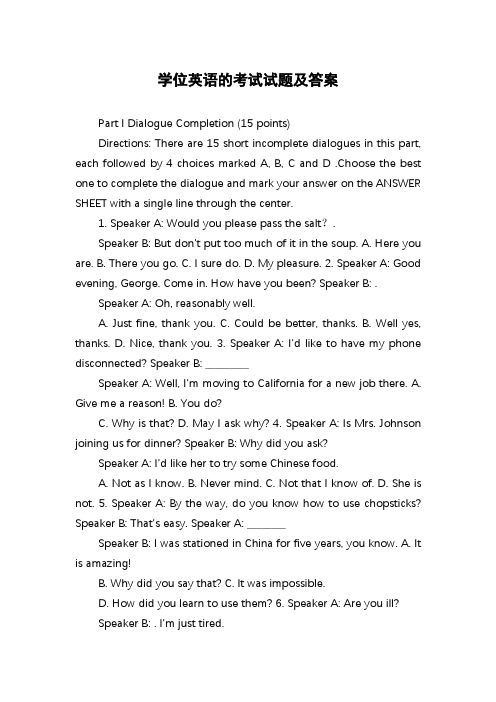
学位英语的考试试题及答案Part I Dialogue Completion (15 points)Directions: There are 15 short incomplete dialogues in this part, each followed by 4 choices marked A, B, C and D .Choose the best one to complete the dialogue and mark your answer on the ANSWER SHEET with a single line through the center.1. Speaker A: Would you please pass the salt?.Speaker B: But don’t put too much of it in the soup. A. Here you are. B. There you go. C. I sure do. D. My pleasure. 2. Speaker A: Good evening, George. Come in. How have you been? Speaker B: .Speaker A: Oh, reasonably well.A. Just fine, thank you. C. Could be better, thanks.B. Well yes, thanks. D. Nice, thank you. 3. Speaker A: I’d like to have my phone disconnected? Speaker B: _________Speaker A: Well, I’m moving to California for a new job there. A. Give me a reason! B. You do?C. Why is that?D. May I ask why? 4. Speaker A: Is Mrs. Johnson joining us for dinner? Speaker B: Why did you ask?Speaker A: I’d like her to try some Chinese food.A. Not as I know.B. Never mind.C. Not that I know of.D. She is not. 5. Speaker A: By the way, do you know how to use chopsticks? Speaker B: That’s easy. Speaker A: ________Speaker B: I was stationed in China for five years, you know. A. It is amazing!B. Why did you say that?C. It was impossible.D. How did you learn to use them? 6. Speaker A: Are you ill?Speaker B: . I’m just tired.A. It’s all right.B. Exactly.C. Not really.D. Don’t mention it. 7. Speaker A: Are you hungry? Speaker B: Hungry?Speaker A: So let’s g o to the Italian restaurant near here.A. I’m starving.B. I don’t know.C. Not yet.D. It’s not my topic. 8. Speaker A: How about the professor’s lecture?1Speaker B: I find it very difficult to follow. ________A. It’s so inspiring.B. It’s beyond me.C. It’s so interesting.D. It’s not my topic. 9. Speaker A: Let’s go to the movies in Prickly tomorrow. Speaker B: Ok, where should we meet?Speaker A: _________ ---name the place and I’ll pick you up. A. I’ll let you know. B. I’ll tell you what. C. You know what. D. You just say it.10. Speaker A: Were you planning to stop by the supermarket? Speaker B: Yes. Would you like me to get you anything? Speaker A: A loaf of bread, ________. A. if anyB. if you likeC. if I were youD. i f you don’t mind11. Speaker A: Do you have any job openings?Speaker B: No, but if you fill out an application, ________.A. we can keep it on file for a yearB. we can put it on noticeC. we’ll see what happensD. we’ll call you when we h ave time12. Speaker A: Hi, Russ. We are having a bit of trouble with the car, so we won’t be able to make it tonight. I’m really sorry. Speaker B: .A. That’s good. I’m busy at the moment, too.B. Well, sorry to hear that. Want me to come get you?C. Don’t worry about it. See you in a while.D. Ok, great. Sorry about the inconvenience.13. Speaker A: Why did you tell the whole world about my past?Speaker B: .A. Oh well, it’s done now. I can’t help.B. I guess it doesn’t matter that much.C. Well, I apologize. I got all excited.D. Sorry. You shouldn’t complain to me.14. Speaker A: Sorry about all the inconvenience. Speaker B:A. Ok. With great pleasure.B. Don’t worry about it.C. Oh, really? That’s ok.D. I’m sorry to hear th at.15. Speaker A: Good morning, Dr. Hampton. May I come in? Speaker B: Good morning, Gretchen. Of course.________2Speaker A: Well, we’ll have a dinner party, and we’d like to invite you especially.A. What do you want to do?B. Do you have anything to say?C. How can I be of help?D. Can you tell me why you are here?PART II Reading Comprehension (40 points )Directions: There are 4 passages in this part. Each of the passages is followed by 5 questions or unfinished statements. For each of them there are 4 choices marked A,B,C and D. Choose the best one and mark your answer on the ANSWER SHEET with a single line through the center.Passage onePlastic bags are fast choking our planet. They are expensive for not only consumers but also the environment; the need of the hour is therefore to come up with eco-friendly bags. Environment friendly bags are the latest and most fashionable to bit the market. Environment friendly people want to be associated and seen with natural fiber bags. Multicolored patch work bags and printed bags areeveryone’s favorite. Most eco-friendly bags are made of cotton. These bags are very comfortable and elegant. They are not only attractive but also long lasting.A cotton bag is a simple and stylish way to eliminate waste and make a fashion statement. Cotton bags with unique patterns and designs are simple and stylish to carry around. Cotton fiber is soft-touch and most comfortable. Finishing processes of cotton are numerous, reflecting today’s tremendous range and combination of colors and special qualities. The bags are reusable and represent a sustainable alternative to traditional materials.Introducing this exciting new message of environmental sustainability is Kariwala Green Bags, which makes a vast range of environment friendly bags. Its cotton bags are simple yet elegant. The collection is suit all needs and situations: beach bags, wine bottle bags, shopping and gift bags, promotional bags, and fashion bags.The company, with its special emphasis on quality, has taken steps to carry the environmental message to the world ready to embrace a brighter ecological future. With its strong presence in over 42 countries worldwide, the company has transformed the simplest cotton bags into a revolution in the Western world. Be the one to make a resolution to reduce the strain on Mother Nature and look good in the process. To make the earth a better place to live in and to know more about long-lasting and fashionable eco-friendly bags, please visit http://.16. The phrase “to come up with” (Paragraph 1) means “________”.A. to replaceB. to purchaseC. to produceD. to ban17. Cotton bags are becoming popular because they are _______.A. strong and easy to keepB. less costly and washable3C. eco-friendly and fashionableD. light and convenient to carry18. Kariwala is probably ________. A. a new material for making bags B.a manufacturer of bags C. the name of a bag store. D. an advertising agency19. By “revolution” (Para graph 5), the author probably refers to the _______. A. great reduction of white pollution B. a brand new style of bag design C. a new way to promote cotton bags D. widespread use of eco-friendly bags20. The primary purpose of the author is to . A. promote Kariwala cotton bagsB. advocate the advantages of cotton bagsC. highlight the importance of bag designsD. persuade people to follow the fashion Passage TwoA review of more than 160 studies of human subjects has found “clear and compelling evidence” that---all else being equal ---happy people tend to live longer and experience better health than their unhappy peers.The study is the most comprehensive review so far of the evidence linking happiness to health. Its lead author ED Diener analyzed long-term studies of human subjects, experimental human trials, and studies that evaluate the health status of people stressed by natural events.“We reviewed eight different types of studies,” Diener said. “And the general conclusion from each type of study is that your subjective well-being---that is, feeling positive about your life, not stressed out, not depressed---contributes to both long life and better health among healthy populations.”A study that followed nearly 5,000 university students for more than 40 years, for example, found that those who were mostpessimistic as students tended to die younger than their peers. An even longer-term study that followed 180 Catholic nuns from early adulthood to old age found that those who wrote positive accounts of their lives in their early 20s tended to live longer than those who wrote more negative ones.There were a few exceptions, but most of long-term studies the researchers reviewed found that anxiety, depression, a lack of enjoyment of daily activities and pessimism are all associated with higher rates of disease and a shorter life.While happiness might not by itself prevent or cure disease, posive emotions and enjoyment of life do contribute to better health and a longer life, Diener said.“Happiness is no magic bullet,” he said. “But the evidence is clear and compelling that it changes your chances of getting disease or dying young.”421. The word “compelling” (Paragraph 1) means “_______”. A. directB. convincingC. adequateD. conclusive22. According to Paragraph 2, Ed Diener . A. studied the health conditions of the subjects B. conducted experimental human trials C. made long-term studies of human subjects D. review other researchers’ studies23. According to the studies on university students and Catholic nuns, who are more likely to live longer?A. Well-educated people.B. Optimistic people.C. Open-minded people.D. Religious people.24. What is NOT mentioned as relevant to a shorter life? A. Depression and anxiety. B. Lack of enjoyment. C. Constant lack of sleep.D. Stress and pessimism.25. By saying that “Happiness is no magic bullet” (Paragraph 7), Diener means thathappiness . A. is not ever lasting B. is not easy to obtainC. is not a good treatment of diseasesD. is not a guarantee of health and long lifePassage ThreeCold weather has a great effect on how our minds and our bodies work. Maybe that is why there are so many expressions that use the word “cold”. For centuries the body’s blood has been linked closely with emotions. People who show no human emotions or feelings, for example, are said to be cold blooded.Cold-blooded people act in cruel ways. They may do brutal things to others and not by accident. For example, a newspaper says the police are searching for a cold-blooded killer. The killer murdered someone not in self-defense or because he was reacting to anger or fear. He seemed to kill for no reason and with no emotion as if taking someone’s life meant nothing.Cold can affect other parts of the body, the feet, for example. Heavy socks can warm your feet if your feet are really cold. But there is an expression “to get cold feet” that has nothing to do with cold or your feet. The expression means being afraid to do something you have decided to do. For example, you agreed to be president of an organization, but then you learned that all the other officers have resigned. All the work of the organization will be your responsibility. You are likely to get cold feet about being president when you understand the situation.A cold fish is not a fish. It is a person. But it is a person who is unfriendly, unemotional and shows no love or warmth. A cold fishdoes not offer much of himself to anyone else. Someone who is a cold fish does not offer much of himself to anyone else. Someone who is a cold fish could be cold hearted. Now a cold-hearted person is someone who has no sympathy. Several5。
chopsticks 筷子
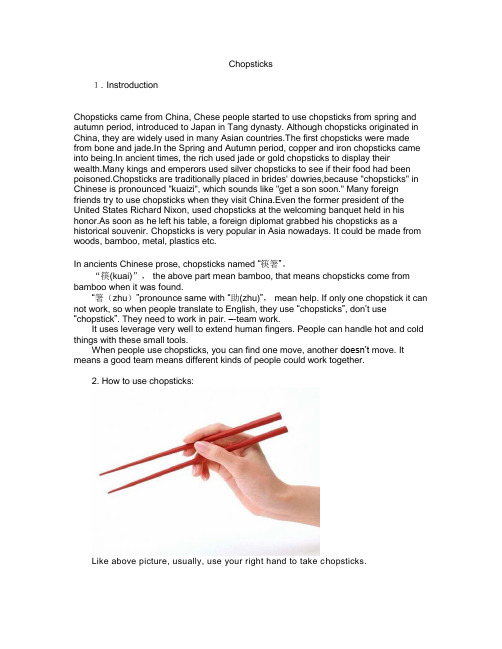
Chopsticks1.InstroductionChopsticks came from China, Chese people started to use chopsticks from spring and autumn period, introduced to Japan in Tang dynasty. Although chopsticks originated in China, they are widely used in many Asian countries.The first chopsticks were made from bone and jade.In the Spring and Autumn period, copper and iron chopsticks came into being.In ancient times, the rich used jade or gold chopsticks to display their wealth.Many kings and emperors used silver chopsticks to see if their food had been poisoned.Chopsticks are traditionally placed in brides' dowries,because "chopsticks" in Chinese is pronounced "kuaizi", which sounds like "get a son soon." Many foreign friends try to use chopsticks when they visit China.Even the former president of the United States Richard Nixon, used chopsticks at the welcoming banquet held in his honor.As soon as he left his table, a foreign diplomat grabbed his chopsticks as a historical souvenir. Chopsticks is very popular in Asia nowadays. It could be made from woods, bamboo, metal, plastics etc.In ancients Chinese prose, chopsticks named “筷箸”。
筷子用英语怎么说
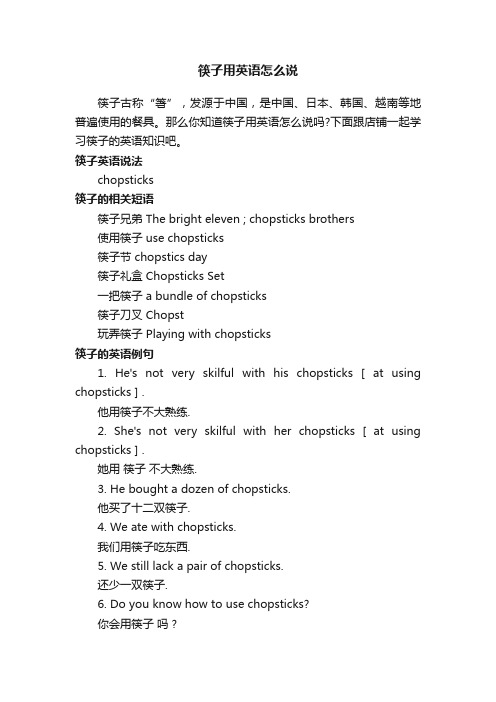
筷子用英语怎么说筷子古称“箸”,发源于中国,是中国、日本、韩国、越南等地普遍使用的餐具。
那么你知道筷子用英语怎么说吗?下面跟店铺一起学习筷子的英语知识吧。
筷子英语说法chopsticks筷子的相关短语筷子兄弟 The bright eleven ; chopsticks brothers使用筷子 use chopsticks筷子节 chopstics day筷子礼盒 Chopsticks Set一把筷子 a bundle of chopsticks筷子刀叉 Chopst玩弄筷子 Playing with chopsticks筷子的英语例句1. He's not very skilful with his chopsticks [ at using chopsticks ] .他用筷子不大熟练.2. She's not very skilful with her chopsticks [ at using chopsticks ] .她用筷子不大熟练.3. He bought a dozen of chopsticks.他买了十二双筷子.4. We ate with chopsticks.我们用筷子吃东西.5. We still lack a pair of chopsticks.还少一双筷子.6. Do you know how to use chopsticks?你会用筷子吗 ?7. The child is still awkward with his chopsticks.那小孩还不太会用筷子.8. I took a straw poll among my colleagues to find out how many can use chopsticks.我在同事中做了一个调查,看多少人会用筷子.9. Hearing that there was an emergency case, the doctor put down his chopsticks and left at once.听说有急诊, 医生撂下筷子就走.10. People don't use chopsticks here, but spoons and forks.这里的人不用筷子, 用勺子和叉子.11. The chopsticks of the diners seldom rested.筷子的往来差不多没有停止过.12. Chopsticks made of celluloid buckle easily in hot water.赛璐璐筷子在热水中容易弯曲.13. The Chinese use chopsticks instead of knives and forks.中国人不用刀叉,用筷子.14. My American friend is learning to eat with chopsticks.我的一位美国朋友在学着用筷子吃饭.15. There are some plates, bowls and chopsticks on the table.在桌上有些盘子、碗和筷子.关于筷子的英文阅读:筷子与关节炎If you've ever tried eating with chopsticks, you know they can be a pain to learn how to use.如果你有用筷子吃过饭,你就知道学习使用它就是一种痛苦。
初三英语初中英语牛津译林版试题答案及解析

初三英语初中英语牛津译林版试题答案及解析1. When she heard her son was absent from school again, she was and beat him.A.out of control B.out of breath C.out of season D.out of work【答案】A【解析】句意:当她听说她的儿子又旷课的时候,她失去了控制打了他。
out of control失去控制;out of breath上气不接下气;out of season不合时宜;out of work失业。
根据句意可知,她听说儿子又旷课,应该是很生气,所以是失去控制打了孩子。
故应选A。
2.六、根据汉语意思完成句子(共10分,每小题2分)【1】无论发生什么事,我们都不会放弃。
Wewill____________________________________________________________________________.【答案】never give up; whatever happens【解析】give up“放弃”,whatever happened“无论发生什么”,故此处为never give up; whatever happens【2】我们学习汉语,也学习英语。
Welearn__________________________________________________________________________.【答案】English as well as Chinese【解析】表示“也”,连接并列宾语,故用连词as well as,故此处为English as well as Chinese 【3】机器人能给我们的生活带来变化吗?Canrobots______________________________________________________________________?【答案】bring any changes to our lives【解析】bring sth to sb“给某人带来某物”,故此处为bring any changes to our lives【4】我后悔没有把事实真相告诉他。
教笔友用筷子英语作文
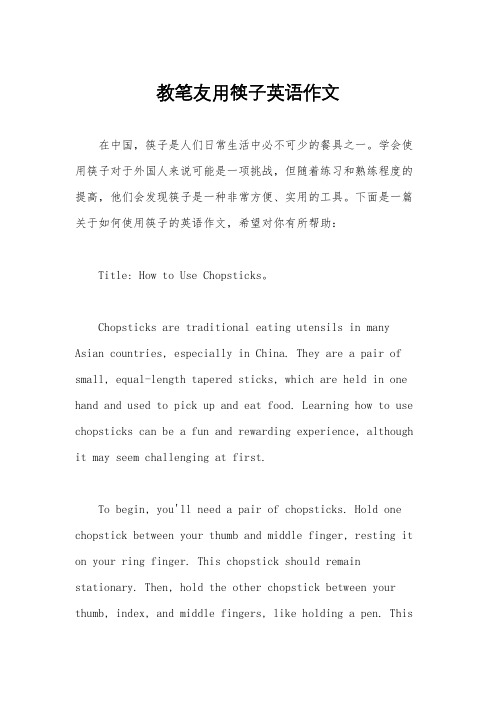
教笔友用筷子英语作文在中国,筷子是人们日常生活中必不可少的餐具之一。
学会使用筷子对于外国人来说可能是一项挑战,但随着练习和熟练程度的提高,他们会发现筷子是一种非常方便、实用的工具。
下面是一篇关于如何使用筷子的英语作文,希望对你有所帮助:Title: How to Use Chopsticks。
Chopsticks are traditional eating utensils in many Asian countries, especially in China. They are a pair of small, equal-length tapered sticks, which are held in one hand and used to pick up and eat food. Learning how to use chopsticks can be a fun and rewarding experience, although it may seem challenging at first.To begin, you'll need a pair of chopsticks. Hold one chopstick between your thumb and middle finger, resting it on your ring finger. This chopstick should remain stationary. Then, hold the other chopstick between your thumb, index, and middle fingers, like holding a pen. Thischopstick is the one you will move to pick up food.Practice opening and closing the chopsticks by moving the top chopstick with your index and middle fingers. Start with larger, easy-to-grasp food items, such as rice or noodles, and gradually move on to smaller items like vegetables or meat. The key is to use the top chopstick as a lever to grip the food between the two chopsticks.Be patient and practice regularly. It may take some time to get the hang of using chopsticks, but with perseverance, you'll improve. Soon, you'll find that using chopsticks is a convenient and enjoyable way to eat.In conclusion, learning how to use chopsticks is a valuable skill that can enhance your dining experience and appreciation for Asian culture. So, grab a pair of chopsticks and start practicing! Who knows, you might become a chopstick pro in no time!。
对外汉语:筷子chopsticks
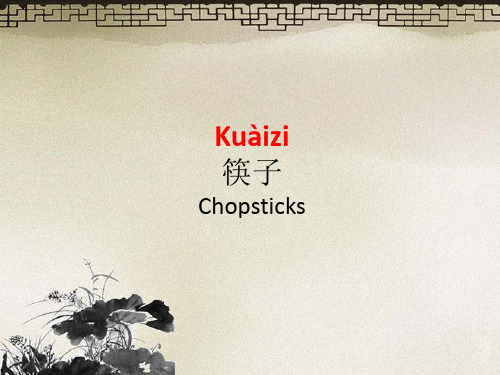
2.筷子的传说
The legends of chopsticks
About the legends of chopsticks
Jiang Ziya was enlightened by God bird, invented sīzhú chopsticks.
Daji invented chopsticks of jade hairpin had won the favor of King Zhou.
四忌插筷。在用餐中途因故需暂时离开时,要把筷子轻轻搁在桌子上 或餐碟边,不能插在饭碗里。Fourth avoid inserting chopsticks in food. If you want to leave for a while in the middle of the meal, please put the chopsticks on the table or plate, can’t be inserted in the bowl. 五忌挥筷。在夹菜时,不能把筷子在菜盘里挥来挥去,上下乱翻,遇 到别人也来夹菜时,要有意避让,谨防“筷子打架”。 Fifth avoid wielding chopsticks. When you are taking food, can’t holding chopsticks move to here and there, hesitant to decide what to eat or turn up and down around the dish; meet with others taking food, intend to give way, beware of “chopsticks fighting”.
使用筷子的几个忌讳
Several taboos of using chopsticks
筷子英语短文带翻译

筷子英语短文带翻译Using Chopsticks: The Art of Eating in Chinese Culture。
使用筷子,中国文化中的饮食艺术。
Chopsticks, also known as "kuai zi" in Mandarin Chinese, are an essential part of Chinese culture and cuisine.Unlike Western utensils such as knives and forks,chopsticks require a certain level of skill and finesse to use properly. In this article, we will explore the history and art of using chopsticks in Chinese culture.筷子,在中文中也被称为“筷子”,是中国文化和美食中不可或缺的一部分。
与西方的刀叉等餐具不同,筷子需要一定的技巧和精湛的技艺才能正确使用。
在本文中,我们将探讨在中国文化中使用筷子的历史和艺术。
History of Chopsticks。
筷子的历史。
The use of chopsticks dates back over 5,000 years in China. It is believed that chopsticks were first used as cooking utensils, as they allowed people to easily stir and move food around in pots and woks. Over time, chopsticks evolved into eating utensils, and became a symbol of Chinese dining culture.使用筷子的历史可以追溯到中国五千年前。
chopsticks
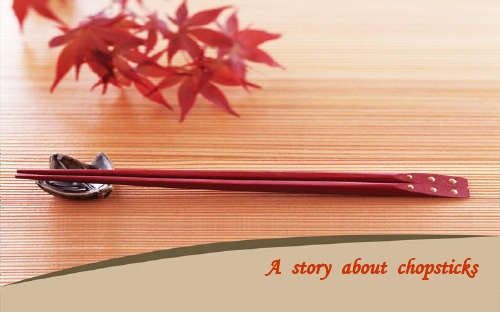
That is details.Then it conveys your quality.
Thanks for your attention
泪箸遗珠
Small chopsticks Big culture
Using chopsticks correctly helps you get along well with others on table.
That is Chinese culture.NOT BORING,NOT STIFF.It teachs us to expect,to be thankful,to inherit.Chopsticks is only a carrier.It leades you to feel ancient people’s life ,attitude and characters.
Can you use chopsticks correctly?
Taboo.1
Don’t use chopsticks to hit the side of the bowl.
敲盏击盅
Taboo.2
Don’t put chopsticks uneven in length.Because it doesn’t only means misfortune but also means death something.
Implied meaning
The material is also elegant.Bamboo,wood are mostly taken.The materials are taken from nature.It is not rude as forks and knife in westen countries.It expresses our philosophy of life.That is harmonious with people , with nature.
如何使用筷子英文作文
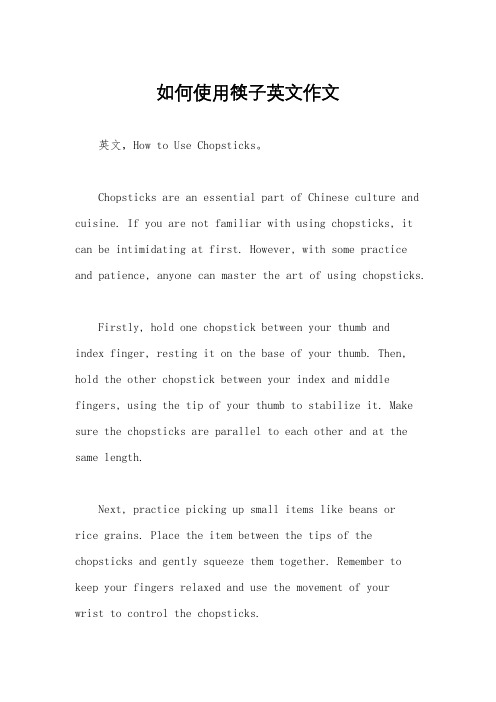
如何使用筷子英文作文英文,How to Use Chopsticks。
Chopsticks are an essential part of Chinese culture and cuisine. If you are not familiar with using chopsticks, it can be intimidating at first. However, with some practice and patience, anyone can master the art of using chopsticks.Firstly, hold one chopstick between your thumb andindex finger, resting it on the base of your thumb. Then, hold the other chopstick between your index and middle fingers, using the tip of your thumb to stabilize it. Make sure the chopsticks are parallel to each other and at the same length.Next, practice picking up small items like beans orrice grains. Place the item between the tips of the chopsticks and gently squeeze them together. Remember to keep your fingers relaxed and use the movement of yourwrist to control the chopsticks.Once you have mastered picking up small items, you can move on to larger items like meat or vegetables. Use one chopstick to hold the item in place while using the otherto cut it into smaller pieces.It is also important to note that there are some chopstick etiquette rules to follow. Do not use your chopsticks to point at someone, and do not stick them vertically into your food. It is also considered rude to pass food from chopstick to chopstick.中文,如何使用筷子。
怎样夹筷子英文作文
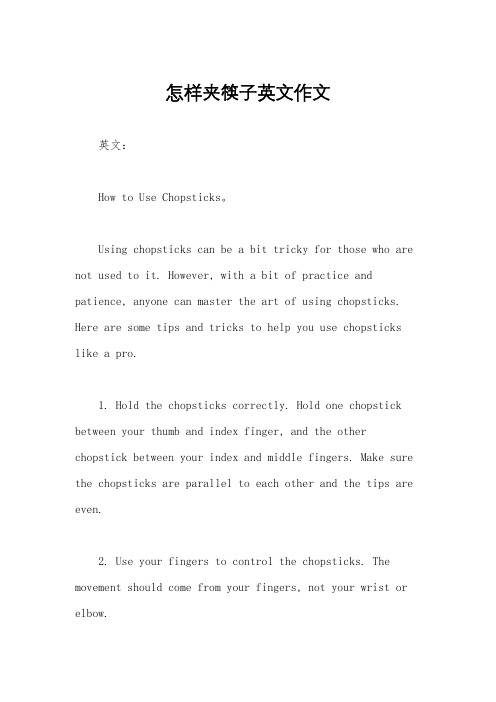
怎样夹筷子英文作文英文:How to Use Chopsticks。
Using chopsticks can be a bit tricky for those who are not used to it. However, with a bit of practice and patience, anyone can master the art of using chopsticks. Here are some tips and tricks to help you use chopsticks like a pro.1. Hold the chopsticks correctly. Hold one chopstick between your thumb and index finger, and the other chopstick between your index and middle fingers. Make sure the chopsticks are parallel to each other and the tips are even.2. Use your fingers to control the chopsticks. The movement should come from your fingers, not your wrist or elbow.3. Practice picking up different objects. Start with larger objects like vegetables or pieces of meat, and then move on to smaller objects like grains of rice or beans.4. Use chopsticks to eat noodles. Twirl the noodles around the chopsticks and lift them to your mouth.5. Don't stab your food. Instead, use a scooping motion to pick up your food.With these tips and some practice, you'll be using chopsticks like a pro in no time.中文:怎样夹筷子。
chopsticks英文作文
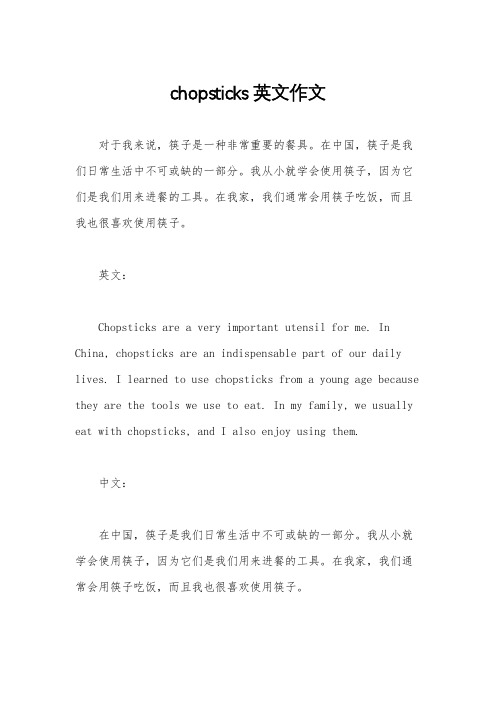
chopsticks英文作文对于我来说,筷子是一种非常重要的餐具。
在中国,筷子是我们日常生活中不可或缺的一部分。
我从小就学会使用筷子,因为它们是我们用来进餐的工具。
在我家,我们通常会用筷子吃饭,而且我也很喜欢使用筷子。
英文:Chopsticks are a very important utensil for me. In China, chopsticks are an indispensable part of our daily lives. I learned to use chopsticks from a young age because they are the tools we use to eat. In my family, we usually eat with chopsticks, and I also enjoy using them.中文:在中国,筷子是我们日常生活中不可或缺的一部分。
我从小就学会使用筷子,因为它们是我们用来进餐的工具。
在我家,我们通常会用筷子吃饭,而且我也很喜欢使用筷子。
When I was young, my parents taught me how to hold and use chopsticks properly. They showed me the correct way to grip the chopsticks and how to pick up food with them. I remember struggling at first, but with practice, I eventually got the hang of it. Now, using chopsticks feels natural to me, and I find it much easier than using a fork and knife.英文:When I was young, my parents taught me how to hold and use chopsticks properly. They showed me the correct way to grip the chopsticks and how to pick up food with them. I remember struggling at first, but with practice, I eventually got the hang of it. Now, using chopsticks feels natural to me, and I find it much easier than using a fork and knife.中文:当我还小的时候,我的父母教会了我如何正确地握住和使用筷子。
教我怎样拿筷子英文作文
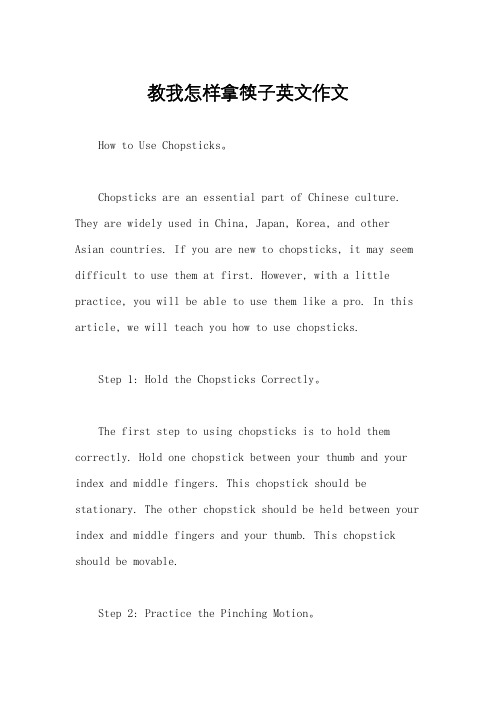
教我怎样拿筷子英文作文How to Use Chopsticks。
Chopsticks are an essential part of Chinese culture. They are widely used in China, Japan, Korea, and other Asian countries. If you are new to chopsticks, it may seem difficult to use them at first. However, with a little practice, you will be able to use them like a pro. In this article, we will teach you how to use chopsticks.Step 1: Hold the Chopsticks Correctly。
The first step to using chopsticks is to hold them correctly. Hold one chopstick between your thumb and your index and middle fingers. This chopstick should be stationary. The other chopstick should be held between your index and middle fingers and your thumb. This chopstick should be movable.Step 2: Practice the Pinching Motion。
Once you have the chopsticks in the correct position, practice the pinching motion. You should be able to open and close the movable chopstick by moving your index and middle fingers. Practice picking up small objects like beans or peas.Step 3: Practice the Scooping Motion。
UsingChopsticks
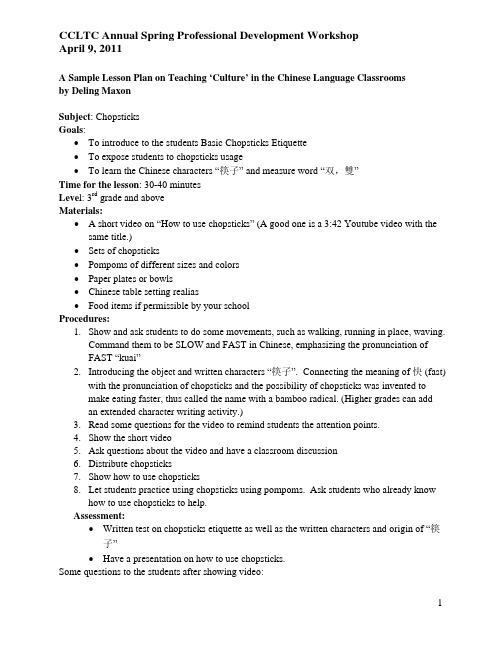
A Sample Lesson Plan on Teaching ‘Culture’ in the Chinese Language Classroomsby Deling MaxonSubject: ChopsticksGoals:• To introduce to the students Basic Chopsticks Etiquette• To expose students to chopsticks usage• To learn the Chinese characters “筷子” and measure word “双,雙”Time for the lesson: 30-40 minutesLeve l: 3rd grade and aboveMaterials:• A short video on “How to use chopsticks” (A good one is a 3:42 Youtube video with the same title.)• Sets of chopsticks• Pompoms of different sizes and colors• Paper plates or bowls• Chinese table setting realias• Food items if permissible by your schoolProcedures:1. Show and ask students to do some movements, such as walking, running in place, waving.Command them to be SLOW and FAST in Chinese, emphasizing the pronunciation ofFAST “kuai”2. Introducing the object and written characters “筷子”. Connecting the meaning of 快 (fast)with the pronunciation of chopsticks and the possibility of chopsticks was invented tomake eating faster, thus called the name with a bamboo radical. (Higher grades can addan extended character writing activity.)3. Read some questions for the video to remind students the attention points.4. Show the short video5. Ask questions about the video and have a classroom discussion6. Distribute chopsticks7. Show how to use chopsticks8. Let students practice using chopsticks using pompoms. Ask students who already knowhow to use chopsticks to help.Assessment:• Written test on chopsticks etiquette as well as the written characters and origin of “筷子”• Have a presentation on how to use chopsticks.Some questions to the students after showing video:Some questions to ask students after showing video:(These can also be use as part of the assessment.)1. Why do we rub wooden disposable chopsticks together before using them?2. Which end of chopsticks is for picking up food, narrow end or broad end?3. Which is not a good practice when dishing out food from the serving plate or bowl? Why?a) Use serving chopsticks or spoonb) Use the broad end of one’s own chopsticksc) Use the narrow end of one’s own chopsticks4. Where should one rest his/her chopsticks?a) On the edge of one’s own bowlb) On the chopstick standc) Any where convenient5. Which is considered bad manner when using chopsticks?a) Do not finish all the food in your bowlb) Digging around in the serving plate or bowl to find your choicec) Picking up food by stabbing at itd) All of the above6. True or false? Never stick and rest chopsticks in a bowl because it is a funeral ritual andis considered a symbol of death.。
如何用筷子英语作文
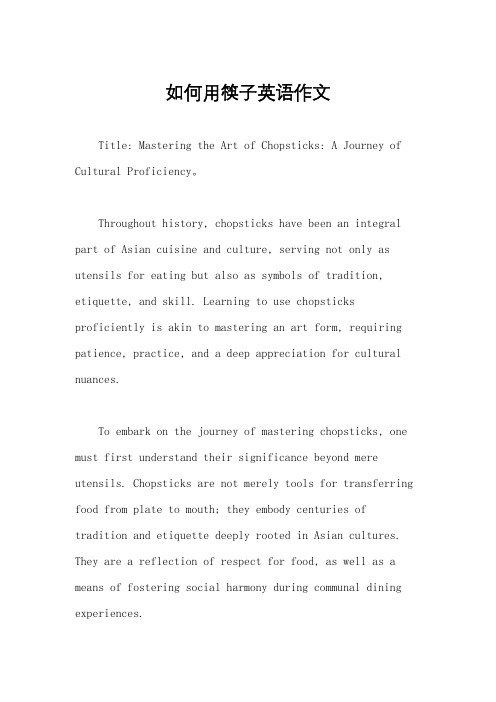
如何用筷子英语作文Title: Mastering the Art of Chopsticks: A Journey of Cultural Proficiency。
Throughout history, chopsticks have been an integral part of Asian cuisine and culture, serving not only as utensils for eating but also as symbols of tradition, etiquette, and skill. Learning to use chopsticks proficiently is akin to mastering an art form, requiring patience, practice, and a deep appreciation for cultural nuances.To embark on the journey of mastering chopsticks, one must first understand their significance beyond mere utensils. Chopsticks are not merely tools for transferring food from plate to mouth; they embody centuries of tradition and etiquette deeply rooted in Asian cultures. They are a reflection of respect for food, as well as a means of fostering social harmony during communal dining experiences.The journey begins with understanding the anatomy of chopsticks. Typically made of wood, bamboo, metal, or plastic, chopsticks consist of two slender sticks of equal length. Unlike Western utensils, chopsticks do not come with predefined roles; both sticks are held in one hand and manipulated to grasp food with precision and finesse.To wield chopsticks with mastery, one must develop proper technique and dexterity. The most common method involves holding one chopstick stationary while using the other to grasp food. The thumb and index finger provide stability, while the middle finger acts as a pivot for controlled movement. It's a delicate balance of coordination and finesse, requiring steady hands and acute concentration.Patience is paramount in the journey of mastering chopsticks. Like any skill worth acquiring, proficiency with chopsticks takes time and dedication. Beginners may struggle at first, fumbling clumsily as they attempt to pick up even the simplest morsels. However, withperseverance and practice, even the most challenging culinary feats can be conquered with ease.Cultural immersion plays a crucial role in honing chopstick skills. Beyond the mechanical aspect of wielding chopsticks lies a deeper understanding of culturaletiquette and traditions. Observing and respecting cultural norms surrounding dining practices is essential, whetherit's the proper way to hold chopsticks, the significance of communal meals, or the etiquette of sharing food.As one progresses on their journey, they develop a newfound appreciation for the artistry of chopsticks. Each successful pick-up becomes a triumph, a testament to one's growing proficiency and cultural fluency. Beyond the practicality of eating, chopsticks become a means of connection—a bridge between past and present, between individuals and cultures.Ultimately, mastering chopsticks transcends mere culinary skill; it is a celebration of cultural diversity and a testament to the human capacity for adaptation andlearning. Whether dining in a bustling Asian metropolis or in the comfort of one's home, the art of chopsticks serves as a reminder of the rich tapestry of traditions that enrich our global community.In conclusion, the journey of mastering chopsticks is a multifaceted exploration of tradition, technique, and cultural understanding. It is a journey marked by patience, practice, and a deep appreciation for the cultural significance of these humble utensils. Through dedication and immersion, one can unlock the full potential of chopsticks, transforming them from simple tools into symbols of cultural proficiency and culinary artistry.。
用筷子的规矩和原因
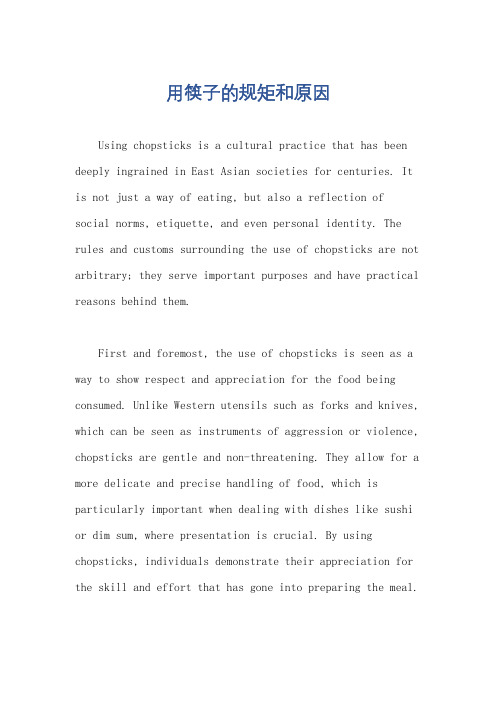
用筷子的规矩和原因Using chopsticks is a cultural practice that has been deeply ingrained in East Asian societies for centuries. It is not just a way of eating, but also a reflection ofsocial norms, etiquette, and even personal identity. The rules and customs surrounding the use of chopsticks are not arbitrary; they serve important purposes and have practical reasons behind them.First and foremost, the use of chopsticks is seen as a way to show respect and appreciation for the food being consumed. Unlike Western utensils such as forks and knives, which can be seen as instruments of aggression or violence, chopsticks are gentle and non-threatening. They allow for a more delicate and precise handling of food, which is particularly important when dealing with dishes like sushi or dim sum, where presentation is crucial. By using chopsticks, individuals demonstrate their appreciation for the skill and effort that has gone into preparing the meal.Furthermore, the use of chopsticks promotes a sense of mindfulness and patience during meals. Unlike using a fork, which can quickly scoop up large portions of food, chopsticks require a more deliberate and focused approach. This slower pace encourages individuals to savor each bite, to pay attention to the flavors and textures, and to be fully present in the moment. In a fast-paced world where meals are often rushed or eaten on the go, the act of using chopsticks can serve as a reminder to slow down and enjoy the simple pleasure of eating.From a practical standpoint, chopsticks are also a more sustainable and eco-friendly option compared to disposable utensils. In many East Asian countries, chopsticks are typically made of bamboo or wood, which are biodegradable and renewable resources. This contrasts with the production and disposal of plastic cutlery, which contributes to environmental pollution and waste. By using chopsticks, individuals can reduce their carbon footprint andcontribute to a more sustainable future.Another reason for using chopsticks is the socialaspect it brings to meals. In East Asian cultures, sharing food is a common practice, and chopsticks facilitate this communal dining experience. By using the same pair of chopsticks to pick up food from shared dishes, individuals create a sense of unity and togetherness. This act symbolizes the bonds of family, friendship, and community, as everyone partakes in the same meal using the same utensils. It fosters a sense of connection and camaraderie, making the dining experience more enjoyable and meaningful.Moreover, the use of chopsticks is deeply rooted in tradition and cultural identity. It is a symbol of heritage and a way to preserve cultural practices that have been passed down through generations. By using chopsticks, individuals honor their ancestors and maintain a connection to their cultural roots. It is a way to celebrate and embrace one's identity, even in a rapidly globalizing world where Western norms and practices often dominate. The use of chopsticks serves as a reminder of the rich history and diversity of East Asian cultures.In conclusion, the use of chopsticks is not just amatter of practicality or personal preference; it is a cultural practice with deep significance and meaning. From showing respect for the food being consumed to promoting mindfulness and sustainability, chopsticks serve various purposes. They bring people together, preserve cultural traditions, and foster a sense of identity and belonging. By understanding and appreciating the rules and customs surrounding the use of chopsticks, individuals can gain a deeper appreciation for the cultural values they represent.。
我要用筷子怎么说英语作文
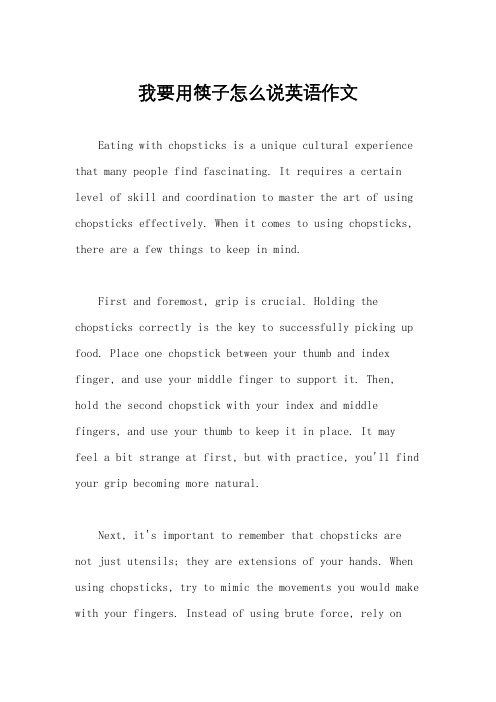
我要用筷子怎么说英语作文Eating with chopsticks is a unique cultural experience that many people find fascinating. It requires a certain level of skill and coordination to master the art of using chopsticks effectively. When it comes to using chopsticks, there are a few things to keep in mind.First and foremost, grip is crucial. Holding the chopsticks correctly is the key to successfully picking up food. Place one chopstick between your thumb and index finger, and use your middle finger to support it. Then, hold the second chopstick with your index and middle fingers, and use your thumb to keep it in place. It mayfeel a bit strange at first, but with practice, you'll find your grip becoming more natural.Next, it's important to remember that chopsticks are not just utensils; they are extensions of your hands. When using chopsticks, try to mimic the movements you would make with your fingers. Instead of using brute force, rely onfinesse and precision to pick up food. Think of it as an elegant dance between your chopsticks and the food, where each movement is deliberate and graceful.Another aspect to consider is the etiquette of using chopsticks. In many Asian cultures, it is considered impolite to point your chopsticks at someone or use them to spear food. Instead, use them to gently pick up food and bring it to your mouth. Also, avoid using your chopsticks to dig through a shared dish; instead, use the opposite end or ask for a serving spoon.Furthermore, using chopsticks can be a fun and interactive experience. It's not just about eating; it's about engaging with your food. Experiment with different techniques and styles, such as the "chopstick drumming" method, where you tap the ends of the chopsticks together to make a rhythmic sound. This can add an element of playfulness to your dining experience and make it more enjoyable.Lastly, don't be discouraged if you struggle at first.Like any skill, using chopsticks takes time and practice to master. Start with simple foods like rice or noodles, and gradually move on to more challenging items. Remember, it's all about finding your own rhythm and style when using chopsticks.In conclusion, using chopsticks is not just a way to eat; it's a cultural experience that can be both challenging and enjoyable. With the right grip, finesse, and etiquette, you can fully embrace the art of using chopsticks and appreciate the unique connection it creates between you and your food. So, next time you have the opportunity, give chopsticks a try and embark on a culinary adventure.。
筷子的英语作文(使用
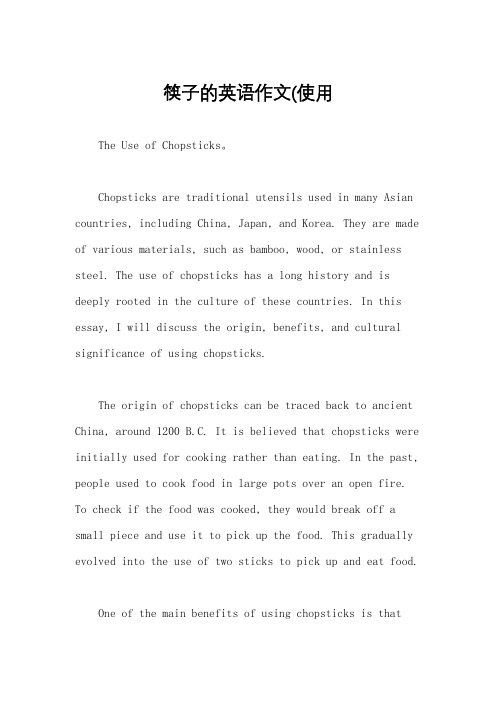
筷子的英语作文(使用The Use of Chopsticks。
Chopsticks are traditional utensils used in many Asian countries, including China, Japan, and Korea. They are made of various materials, such as bamboo, wood, or stainless steel. The use of chopsticks has a long history and is deeply rooted in the culture of these countries. In this essay, I will discuss the origin, benefits, and cultural significance of using chopsticks.The origin of chopsticks can be traced back to ancient China, around 1200 B.C. It is believed that chopsticks were initially used for cooking rather than eating. In the past, people used to cook food in large pots over an open fire. To check if the food was cooked, they would break off a small piece and use it to pick up the food. This gradually evolved into the use of two sticks to pick up and eat food.One of the main benefits of using chopsticks is thatthey promote portion control. Unlike Western utensils like forks and spoons, chopsticks require more effort and precision to use. This encourages people to take smaller bites and eat at a slower pace. As a result, they are more likely to feel full and satisfied with smaller amounts of food. This can be beneficial for weight management and preventing overeating.Another advantage of using chopsticks is that they allow for a more delicate handling of food. The fine tips of the chopsticks enable users to pick up even the tiniest pieces of food with ease. This is particularly useful when eating dishes like sushi or dumplings, where precision is essential. Moreover, chopsticks are less likely to damage delicate ingredients, such as fish or tofu, compared to other utensils.Furthermore, the use of chopsticks has significant cultural significance. In many Asian countries, eating with chopsticks is considered a form of etiquette and respect. It is believed that using chopsticks shows appreciation for the effort put into preparing the meal and demonstratesgood table manners. Additionally, the act of sharing food from a communal dish using chopsticks symbolizes unity and harmony within a family or group.Using chopsticks also requires a certain level of skill and practice. Children in Asian countries are taught from a young age how to hold and use chopsticks correctly. This helps to develop fine motor skills and hand-eye coordination. Furthermore, the art of using chopsticks is often seen as a reflection of one's upbringing and education. Therefore, mastering the use of chopsticks is considered a sign of refinement and cultural sophistication.In conclusion, chopsticks are traditional utensils with a long history and cultural significance in many Asian countries. They offer benefits such as portion control and delicate handling of food. The use of chopsticks also promotes etiquette, respect, and unity within a family or group. Overall, chopsticks are not just a tool for eatingbut a symbol of culture, tradition, and refinement.。
HowtoUseChopsticks
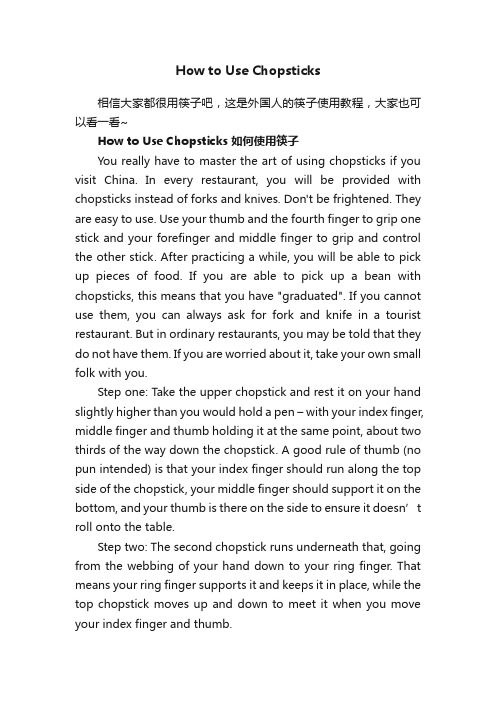
How to Use Chopsticks相信大家都很用筷子吧,这是外国人的筷子使用教程,大家也可以看一看~How to Use Chopsticks 如何使用筷子You really have to master the art of using chopsticks if you visit China. In every restaurant, you will be provided with chopsticks instead of forks and knives. Don't be frightened. They are easy to use. Use your thumb and the fourth finger to grip one stick and your forefinger and middle finger to grip and control the other stick. After practicing a while, you will be able to pick up pieces of food. If you are able to pick up a bean with chopsticks, this means that you have "graduated". If you cannot use them, you can always ask for fork and knife in a tourist restaurant. But in ordinary restaurants, you may be told that they do not have them. If you are worried about it, take your own small folk with you.Step one: Take the upper chopstick and rest it on your hand slightly higher than you would hold a pen – with your index finger, middle finger and thumb holding it at the same point, about two thirds of the way down the chopstick. A good rule of thumb (no pun intended) is that your index finger should run along the top side of the chopstick, your middle finger should support it on the bottom, and your th umb is there on the side to ensure it doesn’t roll onto the table.Step two: The second chopstick runs underneath that, going from the webbing of your hand down to your ring finger. That means your ring finger supports it and keeps it in place, while the top chopstick moves up and down to meet it when you move your index finger and thumb.Confused? Let’s look at it another way. Take two pens. Hold one like you normally would, between your thumb, index and middle finger. Okay, now take the second pen and slide it underneath that one. Now make the top pen go up and down.Bingo. You’ve just learned how to use chopsticks. Some people use all five fingers, using their little finger to help guide the bottom chopstick –that just ain’t right. So don’t do it.So you’ve got your chopstick technique down – now what?Well, etiquette and style matter too –especially if you’re dining with a Japanese person. Follow these rules and you won’t go wrong in that area:Don’t suck your chopsticks. It’s kinda gross.If you’re holding your chopsticks, don’t pick up a bowl without putting the sticks down. That’s kinda like grabbing for the ketchup while still holding your fork – definitely uncool.Passing food from your sticks to someone else’s? Nice party trick, bad party form.Using your chopstick like a flagpole, and sticking it down into your rice so it stands up… also not cool, which should be readily apparent to anyone older then three years of age.Don’t wave your sticks around when you talk. Would you do that with your soup s poon? Didn’t think so.Last but not least –don’t spear your food and pick it up with your chopsticks. You might think nobody is watching, but trust me, someone always spots you when you’re behaving like Jungle Jim on a first date.。
建议信怎样用筷子
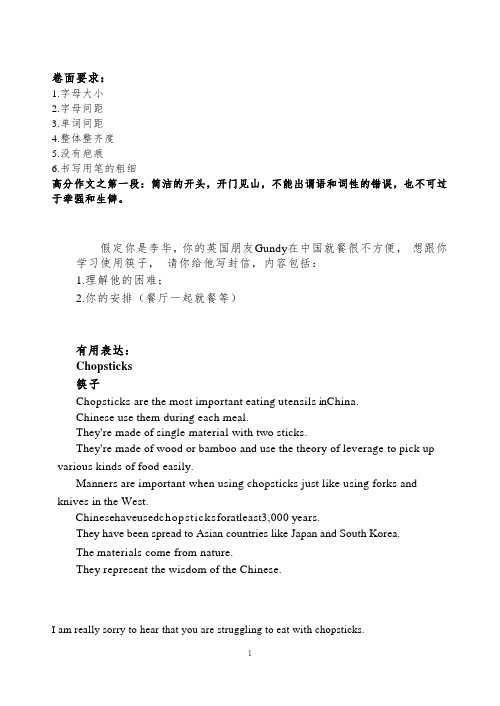
卷面要求:1.字母大小2.字母间距3.单词间距4.整体整齐度5.没有疤痕6.书写用笔的粗细高分作文之第一段:简洁的开头,开门见山,不能出谓语和词性的错误,也不可过于牵强和生僻。
假定你是李华,你的英国朋友Gundy在中国就餐很不方便,想跟你学习使用筷子,请你给他写封信,内容包括:1.理解他的困难;2.你的安排(餐厅一起就餐等)有用表达:Chopsticks筷子Chopsticks are the most important eating utensils in China.Chinese use them during each meal.They're made of single material with two sticks.They're made of wood or bamboo and use the theory of leverage to pick up various kinds of food easily.Manners are important when using chopsticks just like using forks and knives in the West.Chinesehaveusedchopsticksforatleast3,000 years.They have been spread to Asian countries like Japan and South Korea.The materials come from nature.They represent the wisdom of the Chinese.I am really sorry to hear that you are struggling to eat with chopsticks.I am terribly sorry to hear that you are struggling with chopsticks while having meals.I can imagine the awkward situation you are in.The truth is that it is quite normal for foreigners who use chopsticks for the first time.The truth is that it is common for foreign friends who have been used to knives and forks.Here are some beginners tips that you can try to work out the situation.If it is convenient for/to you, we can get together next week in our school dining hall so that I can show you how to use them skillfully as well as presenting some necessary table manners you have to pay attention to.If convenient, we can get together….One way to be proficient in using them is to practice more.How to give advice:...is one of the best ways to......will also help/work.It may also be helpful to...Have you thought about/tried ...?In my experience, ... works really well.One thing you could/should/have to do is ...Wouldn’t it be great if ...?...is one of the best ways to......might be a perfect option.... is worth a try....might be a good solution.The more/sooner you...., the better.As the proverb says, ...As the saying goes,...范文:Dear Gundy,I’m really sorry to hear that you are confronted/faced with such an awkward situation while using chopsticks. The truth is that it is quite common/not rare for foreign friends like you who have been used to eating with forks and knives.As a typically used dining utensil/tool in China,Chopsticks are challenging for every beginner and even we Chinese sometimes cannot excel at it, so don’t worry too much. I will try my best to help you out. Would it be great if we have meals together next week in our school canteen so that I could show you the secret to using them skillfully/how to use them skillfully as well as presenting some table manners you should pay attention to. Besides, finding some videos online is also worth a try. As the proverb says, practice makes perfect. The sooner you begin to practice, the better.Tricky as it might be, you will master/acquire the skill with a little determination and patience.。
- 1、下载文档前请自行甄别文档内容的完整性,平台不提供额外的编辑、内容补充、找答案等附加服务。
- 2、"仅部分预览"的文档,不可在线预览部分如存在完整性等问题,可反馈申请退款(可完整预览的文档不适用该条件!)。
- 3、如文档侵犯您的权益,请联系客服反馈,我们会尽快为您处理(人工客服工作时间:9:00-18:30)。
• Confused? Let’s look at it another way. Take two pens. Hold one like you normally would, between your thumb, index and middle finger. Okay, now take the second pen and slide it underneath that one. Now make the top pen go up and down.
• The two extremely popular designs for foreigners are the chopsticks engraved with Peking Opera masks or those decorated with the Chinese zodiac animals," he says, adding that Chinese patrons prefer chopsticks engraved with golden dragons, phoenix patterns or Chinese surnames for gifts.
• some young people, especially girls, buy chopsticks as a gift to their close single friends or even for themselves to say goodbye to their single life as soon as possible
• Using your chopstick like a flagpole, and sticking it down into your rice so it stands up… also not cool, which should be readily apparent to anyone older then three years of age. • Don’t wave your sticks around when you talk. Would you do that with your soup spoon? Didn’t think so. • Last but not least – don’t spear your food and pick it up with your chopsticks. You might think nobody is watching, but trust me, someone always spots you when you’re behaving like Jungle Jim on a first date.
• Well, etiquette and style matter too – especially if you’re dining with a Japanese person. Follow these rules and you won’t go wrong in that area: • Don’t suck your chopsticks. It’s kinda gross. • If you’re holding your chopsticks, don’t pick up a bowl without putting the sticks down. That’s kinda like grabbing for the ketchup while still holding your fork – definitely uncool. • Passing food from your sticks to someone else’s? Nice party trick, bad party form.
• Ornately decorated chopsticks have been a favorite for European tourists and airport gift shops are filled with a colorful array of these souvenirs.
• More than 30 percent of the world uses chopsticks and these simple eating utensils have been placed on Asian dinner tables for thousands of years. But these icons of Chinese culture are today also acting as special presents with special symbolic meaning. And the younger generation also wants to cut down on the estimated 45 billion pairs of wooden chopsticks dumped in rubbish bins each year.
• "The chopsticks say that husband and wife will always be a pair and will never be apart.
• chopsticks bear a similar Chinese pronunciation to that of happiness." • Chopsticks in Mandarin is kuai zi (筷子) and happiness is kuai le (快乐).
• Step one: Take the upper chopstick and rest it on your hand slightly higher than you would hold a pen – with your index finger, middle finger and thumb holding it at the same point, about two thirds of the way down the chopstick. A good rule of thumb is that your index finger should run along the top side of the chopstick, your middle finger should support it on the bottom, and your thumb is there on the side to ensure it doesn’t roll onto the table. •
• Step two: The second chopstick runs underneath that, going from the webbing of your hand down to your ring finger. That means your ring finger supports it and keeps it in place, while the top chopstick moves up and down to meet it when you move your index finger and thumb.
• You really have to master the art of using chopsticks if you visit China. In every restaurant, you will be provided with chopsticks instead of forks and knives. Don't be frightened. They are easy to use. Use your thumb and the fourth finger to grip one stick and your forefinger and middle finger to grip and control the other stick. After practicing a while, you will be able to pick up pieces of food. If you are able to pick up a bean with chopsticks, this means that you have "graduated". If you cannot use them, you can always ask for fork and knife in a tourist restaurant. But in ordinary restaurants, you may be told that they do not have them. If you are worried about it, take your own small folk with you.
